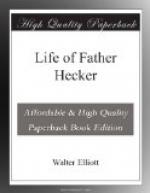During the mission at St. Bridget’s—that is, in the first half of the month of May—Father Hecker arrived in New York and measures were at once taken for the practical organization of the new community. Nothing was done hurriedly; a fair and full consideration of all questions from every point of view, which lasted until early in the month of July, enabled each one clearly to understand his new relation in its every aspect. Father Walworth not being entirely in agreement with the others, withdrew to the diocese of Albany and took charge of a parish; he returned again in 1861, remaining with the community till 1865, when his health becoming quite shattered, he reluctantly decided to withdraw altogether. It need hardly be said that the relations between him and the community have always been most cordial. Meantime the others, Fathers Hecker, Hewit, Deshon, and Baker, organized by electing the first-named the Superior, and drew up and signed what was termed a Programme of Rule. This was submitted to Archbishop Hughes and by him approved and signed on July 7, 1858. The Apostle of the Gentiles was chosen as patron, and the name selected was, The Missionary Priests of St. Paul the Apostle, which has been popularized into Paulists. The habit agreed upon was in form somewhat like that of the students of the Propaganda in Rome, black throughout, with a narrow linen collar and buttoned across the breast, being held at the waist by a cincture.
The Programme of Rule adopts an order of spiritual exercises similar to that observed by the Fathers while Redemptorists. A perpetual voluntary agreement takes the place of the vows as the security of stability, the members affirming that they are fully determined to promote their sanctification by leading a life in all essential respects similar to that led in the religious orders. Besides the chastity imposed upon them by the priesthood the other evangelical counsels of obedience and poverty are adopted and their observance enjoined upon the members, together with the daily and periodical exercises of community life. As to the external vocation, the missions are named as the basis of general apostolic labors, and parish work also, though in a subordinate degree. The entire document looks forward to a complete Rule to be drawn up and submitted to the Holy See at a future day, for which it actually furnished the outlines some twenty years afterwards. The approval of the Programme of a Rule by the Archbishop of New York gave the Fathers the canonical status anticipated by the decree Nuper nonnulli. This was confirmed by an official permission of the Holy See to the Archbishop of New York to establish the Paulist Institute in his diocese, with the consent of his suffragans, which was asked for and obtained.
A little more than a fortnight after these events Father Hecker wrote as follows to a friend:




